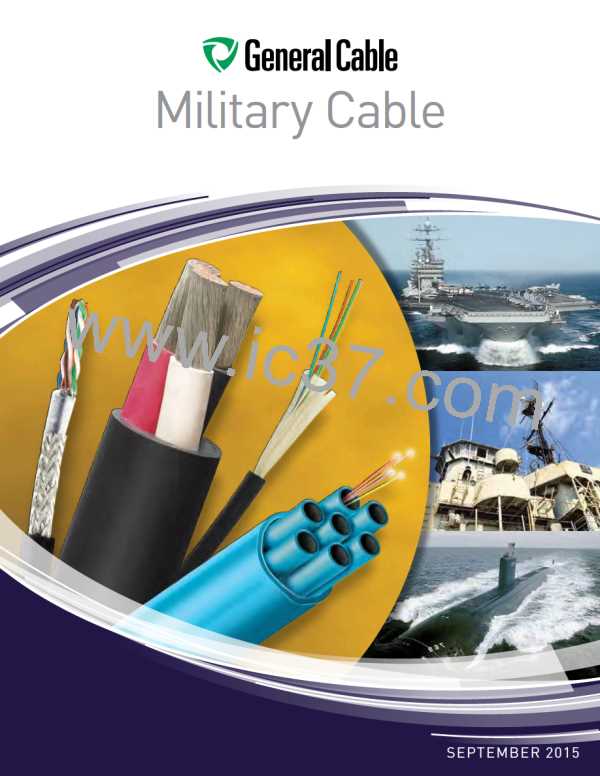Technical Information
Military Shipboard Catalog
Glossary
Breakdown Voltage: The voltage at
which the insulation between two
conductors breaks down.
CE Code, CEC: Canadian Electrical Code Compound: An insulating or jacketing
material made by mixing two or more
Certified Test Report (CTR): A report
providing actual test data on a cable.
Tests are normally conducted by the
Quality Control Department to confirm
that the product being shipped conforms
to specifications
polymeric ingredients.
B & S Gauge: The same as American
Concentric Stranded Conductors:
Manufactured to ASTM, ICEA, and
CSA standards. The most common
fixed installation type conductors are:
1) Round no diameter reduction: 2)
Compressed approximately 3%
diameter reduction; 3) Compact
approximately 10% diameter
reduction.
Wire Gauge (AWG).
Buffer: A protective coating over an
optical fiber.
Characteristic Impedance: The impedance
that, when connected to the output
Building Wire: A general term used
for light and power wiring products,
1000 volts or less.
terminals of a transmission line of any
length, makes the line appear infinitely
long. The ratio of voltage to current at
Bunch Stranding: A group of wires of
the same diameter twisted together
without a predetermined pattern.
Used in flexible cords and cables.
every point along a transmission line on Concentric Stranding: A central wire
which there are no standing waves.
surrounded by one or more layers of
helically wound strands in a fixed
round geometric arrangement.
Circular Mil (cmil): The area of a circle
one mil (.001=D3) in diameter (7.854 x
10-7 sq in). Used in expressing wire
cross-sectional area.
Buried Cable: A cable installed
directly in the earth without use of
underground conduit. Also called
direct burial cable.
Concentricity: The measurement of the
location of the center of the conductor
with respect to the geometric center of
the surrounding insulation.
Circuit Sizes: A popular term for building
wire sizes 14 through 10 AWG.
Butyl Rubber: A synthetic rubber with
good insulating properties (i.e. low
voltage cords).
Conductivity: The capacity of a material
to carry electrical current usually
expressed as a percentage of copper
conductivity (copper being 100%).
Cladding: (1) A method of applying a layer
of metal over another metal whereby
the junction of the two metals is
Cable: An insulated conductor, or
group of individually insulated
conductors in one assembly.
continuously welded. (2) A low
refractive index material that surrounds Conductor: An uninsulated wire suitable
the core of an optical fiber causing the
transmitted light to travel down the core
and protects against surface
for carrying electrical current.
Cabling: The twisting together of two
or more insulated conductors to
form a cable.
Conductor Shield: An extrusion of black
semi-conducting thermoset material
over the conductor to provide a
smooth interface with the insulation
for even distribution of electrical
stress.
contaminant scattering.
Coaxial Cable: A cable consisting of two
cylindrical conductors with a common
axis, separated by a dielectric.
Capacitance: The ratio of the
electrostatic charge on a conductor
to the potential difference between
the conductors required to maintain
that charge. Units expressed in
Farads.
Cold Flow: Permanent deformation of the
insulation or jacket due to mechanical
force or pressure, (not due to heat
softening).
Conduit (Electrical Raceway): A tube or
pipe in which insulated wires and
cables are run
Capacitive Coupling: Electrical
interaction between two conductors
caused by the capacitance between
them.
Connector: A device used to physically
and electrically connect two or more
conductors. Also used to physically
connect cable to equipment.
Color Code: A system for circuit
identification through use of solid
colors and contrasting tracers.
Capacitive Reactance (Xc): The
opposition to alternating current due
to the capacitance of the cable or
circuit. Measured in ohms.
Composite Cable: One containing more
than one type or gauge size of
Continuity Check: A test to determine
whether electrical current flows
continuously throughout the length of
a single wire or individual wires in a
cable.
conductors (e.g. power and control
conductors in one assembly).
Phone: (866) 248-7060
Fax: (859) 572-8463
www.generalcable.com

 GENERAL [ GENERAL CABLE TECHNOLOGIES CORPORATION ]
GENERAL [ GENERAL CABLE TECHNOLOGIES CORPORATION ]